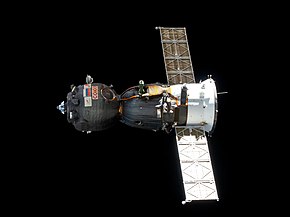 Soyuz MS, the latest version of the spacecraft | |
| Manufacturer | Energia |
|---|---|
| Country of origin | Soviet Union, Russia |
| Operator | Soviet space program (1967–1991) Roscosmos (1992–present) |
| Applications | Carry cosmonauts to orbit and back (originally for Soviet Moonshot and Salyut and Mir space station transportation) |
| Specifications | |
| Crew capacity | 3 |
| Regime | Low Earth orbit, Medium Earth orbit (circumlunar spaceflight during early program) |
| Design life | Up to 6 months (docked to International Space Station) |
| Production | |
| Status | In service |
| Maiden launch | Kosmos 133: 28 November 1966 (uncrewed) Soyuz 1: 23 April 1967 (crewed) |
| Last launch | Latest launch: Soyuz MS-26 11 September 2024 (crewed) |
| Related spacecraft | |
| Derivatives | Shenzhou, Progress |
Soyuz (Russian: Союз, IPA: [sɐˈjus], lit. 'Union') is a series of spacecraft which has been in service since the 1960s, having made more than 140 flights. It was designed for the Soviet space program by the Korolev Design Bureau (now Energia). The Soyuz succeeded the Voskhod spacecraft and was originally built as part of the Soviet crewed lunar programs. It is launched atop the similarly named Soyuz rocket from the Baikonur Cosmodrome in Kazakhstan.
Following the Soviet Union's dissolution, Roscosmos, the Russian space agency, continued to develop and utilize the Soyuz. Between the Space Shuttle's 2011 retirement and the SpaceX Crew Dragon's 2020 debut, Soyuz was the sole means of crewed transportation to and from the International Space Station, a role it continues to fulfill. The Soyuz design has also influenced other spacecraft, including China's Shenzhou and Russia's Progress cargo vehicle.
The Soyuz is a single-use spacecraft composed of three main sections. The descent module is where cosmonauts are seated for launch and reentry. The orbital module provides additional living space and storage during orbit but is jettisoned before reentry. The service module, responsible for propulsion and power, is also discarded prior to reentry. For added safety and aerodynamics, the spacecraft is encased within a fairing with a launch escape system during liftoff.